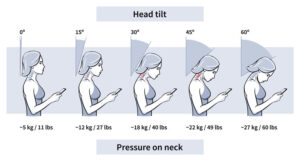The lengthy hours spent in front of a screen or hunched over a phone while scrolling through it pose serious health risks in today’s technology age.
People are more prone to spinal disorders like text-neck syndrome as a result of poor ergonomics and poor posture at work.
Text-neck syndrome is a repetitive strain injury to the neck brought on by protruding your head forward for an extended amount of time. Long-term spinal complexity is brought on by strained and inflexible neck muscles.
The most frequent cause of back and neck discomfort, according to Dr. Tarun Suri, Head of Spine Surgery at Amrita Hospital Faridabad, is improper posture.
Surprisingly, almost 70% of the patients in our OPD fall into this category. Poor screen manners are another major cause of this discomfort. Text-neck syndrome is a condition caused by extended neck bending while using electronic devices, according to Dr. Tarun Suri in a webinar.
The most prevalent age range for those who experience postural back discomfort is 25 to 45. According to studies, bad posture is the main cause of neck and back discomfort in young and middle-aged people, which results in missed work days, trips to the hospital, and expensive treatment costs.
Posture problems over time harm spinal discs, induce muscle spasms, and can result in persistent discomfort, disc degeneration, and in extreme situations, surgery.
Dr. Suri stated, “Recently, we have also seen children between the ages of 10 and 20 suffering from postural spine aches. Back pain in this age range can have many different root causes, including improper posture when studying, excessive device use, and heavy backpacks.
Dr. Suri encouraged us all to break the practice of bending our necks to gaze at screens on electronic devices.
“We should practice raising the screen to eye level to maintain a neutral neck position. Another prevalent unhealthy behavior among many people is tilting the neck while holding a cell phone with the device close to the ear.
For such interactions, it is advised to utilize a loudspeaker or headphones, according to Dr. Suri.
Dr. Srivastava advised avoiding prolonged standing or sitting in one posture and enhancing the ergonomics of the working and living spaces.
The specialists advised sitting with the feet flat on the floor and the hips and knees at a roughly 90-degree angle. Additionally, the back should be neutral and not stooped over or slouched.
After sitting continuously for 20 to 30 minutes, Dr. Suri advised taking a 60-second break to stretch the back to relieve intradiscal tensions and enhance blood flow to the muscles and tissues of the spine.
In order to maintain circulation, flexibility, and strength of the spine muscles, stretching exercises for the neck can be done while using a computer for extended periods of time. Morning exercises can also be beneficial, and these include neck stretches, range-of-motion exercises, shoulder shrugs, and lower back exercises like yoga.




























